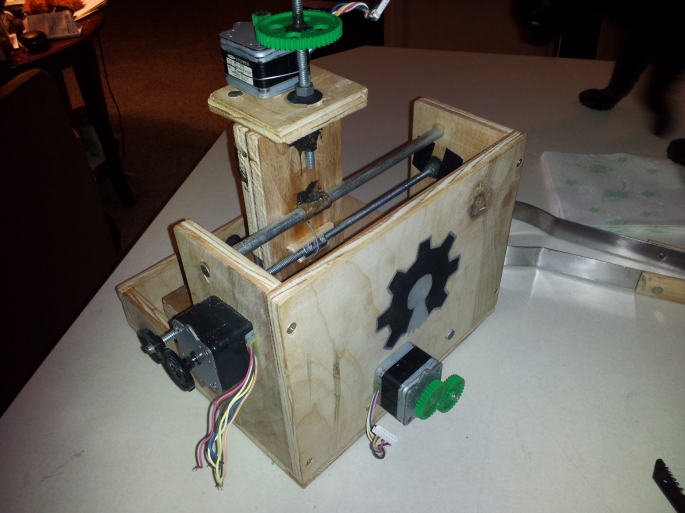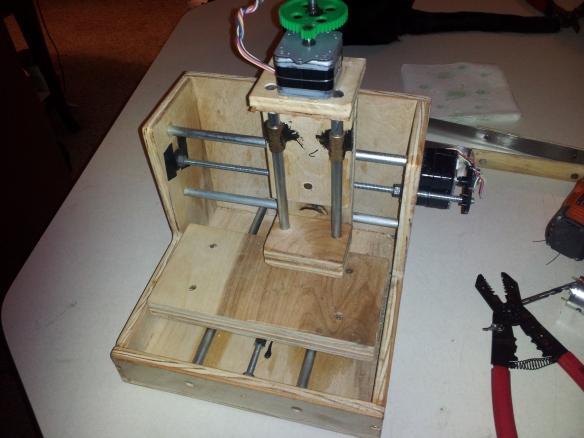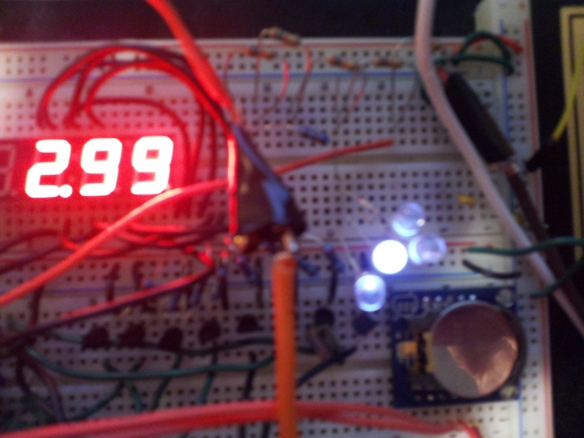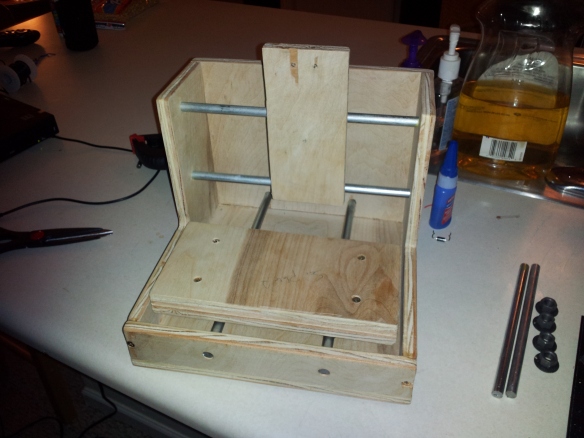Our intelligence and our technology have given us the power to affect the climate. How will we use this power? Are we willing to tolerate ignorance and complacency in matters that affect the entire human family? Do we value short-term advantages above the welfare of the Earth? Or will we think on longer time scales, with concern for our children and our grandchildren, to understand and protect the complex life-support systems of our planet? The Earth is a tiny and fragile world. It needs to be cherished.
– Carl Sagan (1980)
By spending ~$25 and about 15 hours of research all issues that were previously blocking me from being able to calculate exactly where the sun would be on a given day and time have been completely resolved.
So let’s take a look at the mess that this triple-sized breadboard has become:
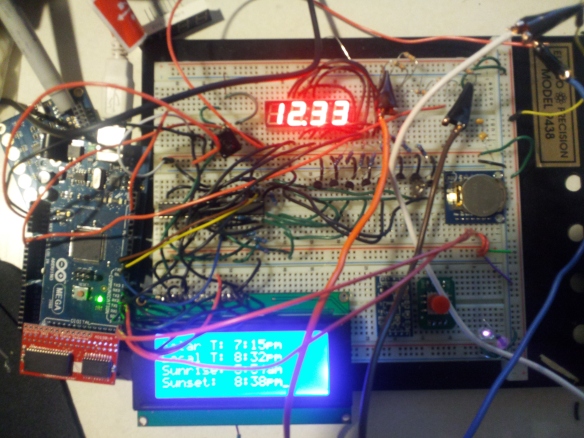
You’ll see a few new things on this board. To the left, attached to the Arduino Mega 2560 is a memory expansion breakout board. This ties directly in to what is unfortunately 40 pins of the board. The good news is that 16 of them can be disabled and are accessible via headers on the expansion board. Doing so disables half of the additional memory the board provides, so it must be used cautiously. More on that later. I haven’t soldered female headers into this yet as I don’t suspect I’ll need them. Any additional sensor requirements can be driven from the available ADC pins. Anything else can be handled through shift registers if necessary.
On the center right of the board, you’ll notice a button battery on a breakout PCB. This is a real time clock module. The battery serves as a method by which the 32.768MHz crystal can oscillate and maintain time when power is not supplied by the microcontroller (MCU). It streams the time to the MCU and allows time accurate to +/- 1 sec/year to be used in all calculations without any external time source.
To the right of the LCD screen there are two other breakouts. The right one is simply a 5-direction switch which will be used to navigate settings menus on the LCD screen once those are coded, so it isn’t being utilized at all. The left one is a 3-axis accelerometer, which provides angle information relative to the earth. This is also not wired at the moment, but will be shortly. It will be used to measure the angle of the solar panel as it is actuated based upon the calculations the MCU provides. Again, more on this in a bit.
MegaRAM Breakout
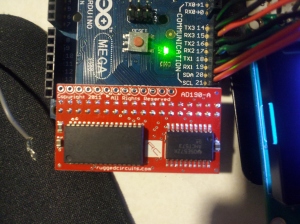
This is the breakout board purchased from [Rugged Circuits]. There are two chips on this circuit. The right chip is a controller that manages communication between the RAM and the MCU. The left chip is the actual RAM. It contains 128Kb of additional memory that is fully integrated into the MCU’s address tables. Mostly. Because the ATMega2560 uses 16 bit addresses, only the first 64Kb of memory is immediately addressable. This includes the 8K of onboard memory as well. By doing nothing but plugging this board in and setting a pin high to power it, 56Kb of additional memory is gained. This leaves 72K unused. Through the onboard controller and some manipulation of timing as well as very careful programming, the 72Kb can be accessed separately, broken out into several separate memory banks. It’s a pain in the ass and unnecessary at the moment. It also eliminates the possibility of using the 16 breakout pins. Because I don’t need it at the moment and I would have to rework a great amount of code I’ve left the total memory at 64Kb (including the base 8K). If I need more it’s there but for now it’s just hanging out laughing at the other RAM as it’s working its ass off. What a dick.
RTC Module
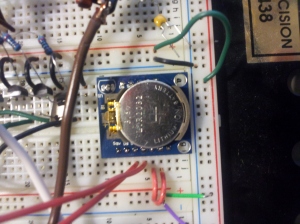 This is the RTC module that’s been touched on a bit already. It has a two wire I2C serial interface with the MCU. I2C is an interesting architecture because it allows 128 separate modules to be strung together through a 6-bit addressing scheme using only a data wire and a clock wire. Well worth the sacrifice of two pins. Also, these are two-way communication pins. The time is settable and readable with some very simple wiring and commands. This module, including shipping, cost a little over $5. Why did I spend so much? Because one excellent feature of this unit is that in addition to being able to manage accurate time through the year 2100, it also has 32Kb of EEPROM that can be read/written. This will be very useful for saving state information relevant to battery charge cycles, sun tracking progress, etc should the unit lose power or be put into a low power standby during its cycle. It can also help save some basic logging/debugging information as the system is built. Before I’m done I’m sure I’ll put an SD card into the mix for some more interesting logging, but for now this will be a very nice to have.
This is the RTC module that’s been touched on a bit already. It has a two wire I2C serial interface with the MCU. I2C is an interesting architecture because it allows 128 separate modules to be strung together through a 6-bit addressing scheme using only a data wire and a clock wire. Well worth the sacrifice of two pins. Also, these are two-way communication pins. The time is settable and readable with some very simple wiring and commands. This module, including shipping, cost a little over $5. Why did I spend so much? Because one excellent feature of this unit is that in addition to being able to manage accurate time through the year 2100, it also has 32Kb of EEPROM that can be read/written. This will be very useful for saving state information relevant to battery charge cycles, sun tracking progress, etc should the unit lose power or be put into a low power standby during its cycle. It can also help save some basic logging/debugging information as the system is built. Before I’m done I’m sure I’ll put an SD card into the mix for some more interesting logging, but for now this will be a very nice to have.
Triple-Axis Accelerometer
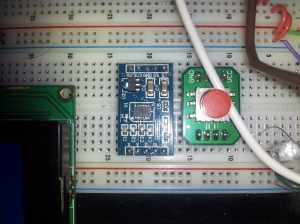 The module on the left is a triple-axis accelerometer (created by Virtuabotix [awesome people to deal with]).
The module on the left is a triple-axis accelerometer (created by Virtuabotix [awesome people to deal with]).
This project only really requires two axis, so the X and Y will be the only ones wired. But a bonus feature of this board is that it has a low-power mode that puts it to sleep when the MCU doesn’t need it. Another interesting feature is free-fall detection. If the board ever experiences zero G, it can set a free-fall pin to high in ~2ms. Again, not needed for this project but probably pretty handy as a “hey by the way this whole thing you spent a lot of time on is hurtling towards the Earth at the exact speed Newton said it would…” alert.
Now to the maths…
Here are three shots which are simply values cycled through the LCD:

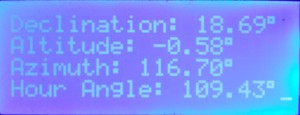

These are the 12 output values currently being calculated. You’ll note the voltage, cell temperature, and power loss due to heat, which have been here for a while now. Below those is the current date and time provided by the RTC. This is what the rest of the calculations mean:
Solar T: This is the solar time. It is the time that the photons currently hitting the earth left the sun, adjusted for the earth’s position in orbit, angle relative to its orbit around the sun and the sun’s wobble as it orbits the galaxy. It’s also off by an additional hour because the sun doesn’t care about daylight savings time.
Local T: Local time, the current time at the MCU’s current place. This is the same as the time provided by the RTC.
Sunrise/Sunset: The sunrise and sunset times for the current day (adjusted for altitude, DST)
Declination: This is a value that fluctuates annually between 23.45°N at the Summer Solstice and 23.45°S at the Winter Solstice. It is displayed here only as information as this value is already encapsulated in other values that are the ones we’re most interested in.
Altitude (Angle): This is how high in the sky the sun appears to be relative to the southern azimuth. This will be a critical value in the final positioning but is also encompassed in another measurement.
Azimuth (Angle): This is how far from the southern azimuth the sun would appear to be if it were at ground level. This is also critical, but also encompassed in other calculations.
Hour Angle: This is the angle of the sun from -90° to 90° as it moves across the sky throughout the day. It is at -90° at sunrise and 90° at sunset. Also a very critical value.
The position of the sun in the sky can be reflected with the hour angle serving as the X axis and the azimuth serving as the Y axis, inverted 90° out of phase.
The accelerometer will provide feedback on the panel’s position regardless of whether or not the panel’s mount is level on the ground. This saves having to worry about the panel’s X-axis being perfectly aligned. The Y-axis, however, can be an issue in that the panel’s mount must be perfectly aligned with the azimuth. Also, the current latitude, longitude and altitude (relative to sea level) values are hard coded. By adding GPS and compass modules, these values could also be computed, making the system entirely autonomous when it comes to seeking and harvesting light.
Time to build the mount.
And to throw in another Carl Sagan quote to complete the posting sandwich.
The neurochemistry of the brain is astonishingly busy, the circuitry of a machine more wonderful than any devised by humans. But there is no evidence that its functioning is due to anything more than the 1014 neural connections that build an elegant architecture of consciousness.
– Carl Sagan (1980)
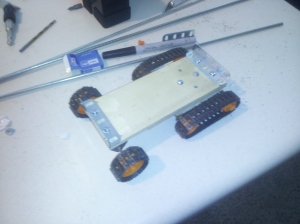 This is the basic construct for a platform that will bear the weight of the battery. It will not have a motorized drive-train as there would be a huge draw of power just bearing the weight of what is above it. It’s made up of a few parts from a Tamiya Tracked Vehicle Chassis. For this project I used a total of three of them. They’re about $15 a pop on eBay.
This is the basic construct for a platform that will bear the weight of the battery. It will not have a motorized drive-train as there would be a huge draw of power just bearing the weight of what is above it. It’s made up of a few parts from a Tamiya Tracked Vehicle Chassis. For this project I used a total of three of them. They’re about $15 a pop on eBay.
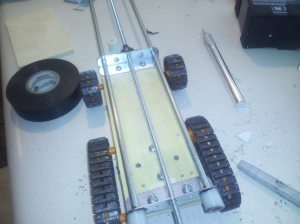
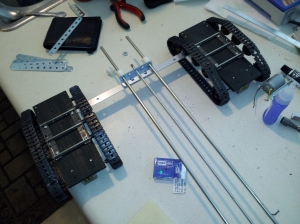

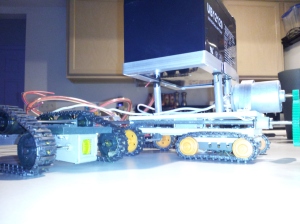
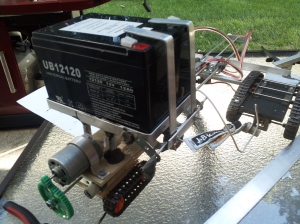

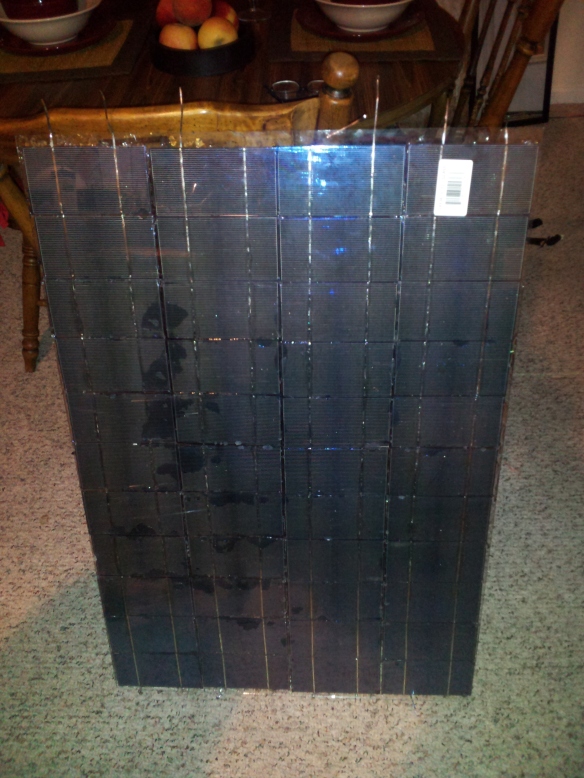
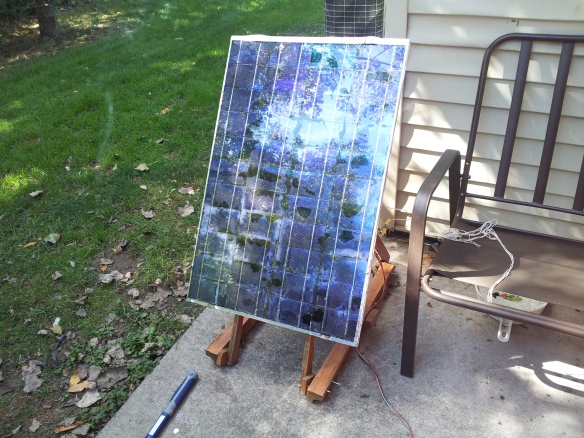
 One of the things I’ve noticed about electronic devices is that they all, unequivocally, run on electricity. Microcontrollers and small motors and actuators and sensors and such are also fairly picky regarding the voltages they’re interested in using. Primarily, microcontrollers require either 5V or 3.3V of power with very little tolerance away from their ideal supply. The flow thus needs to be very regulated.
One of the things I’ve noticed about electronic devices is that they all, unequivocally, run on electricity. Microcontrollers and small motors and actuators and sensors and such are also fairly picky regarding the voltages they’re interested in using. Primarily, microcontrollers require either 5V or 3.3V of power with very little tolerance away from their ideal supply. The flow thus needs to be very regulated.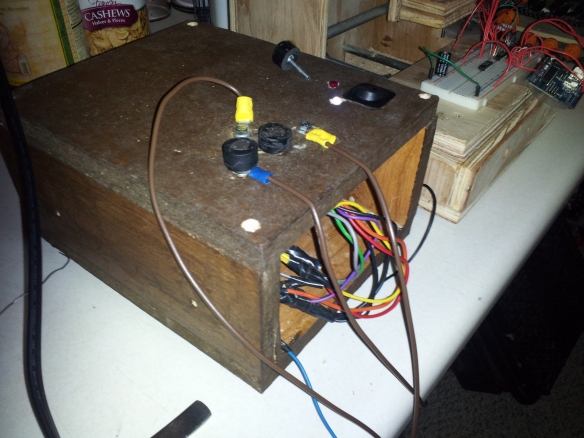
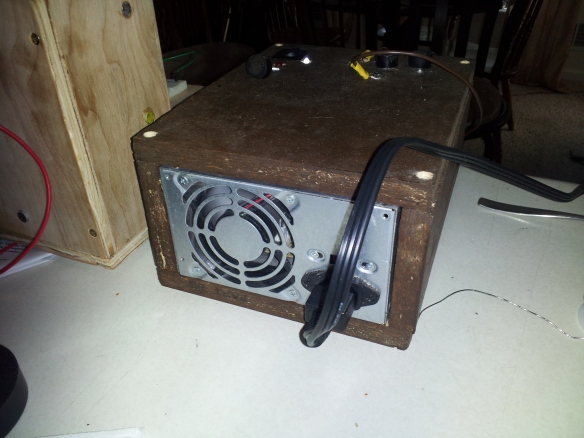
 The Dremel is one of my favorite tools. You can basically accomplish any cutting task with one if you’re patient enough or whatever. Having recently upgraded to a much more powerful model I had the battery-powered model seen here kicking around. Needing something capable of milling and etching for the CNC machine and not wanting to waste the expense to both my wallet and the environmental factors involved in shipping a DC motor overseas I decided to sacrifice the old model.
The Dremel is one of my favorite tools. You can basically accomplish any cutting task with one if you’re patient enough or whatever. Having recently upgraded to a much more powerful model I had the battery-powered model seen here kicking around. Needing something capable of milling and etching for the CNC machine and not wanting to waste the expense to both my wallet and the environmental factors involved in shipping a DC motor overseas I decided to sacrifice the old model.
